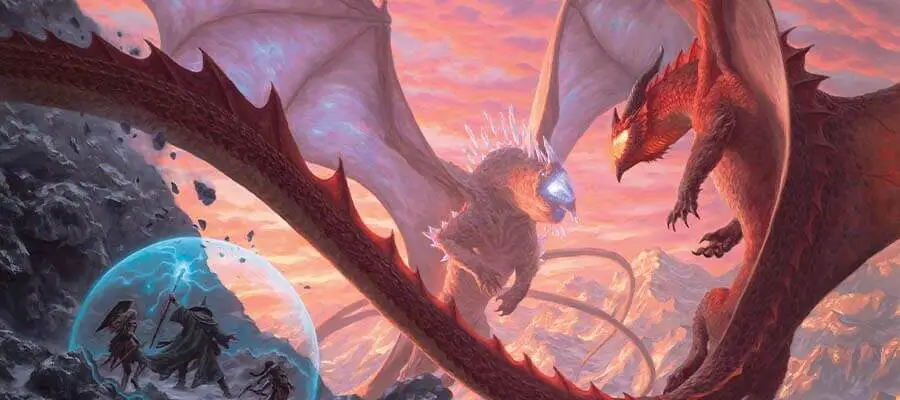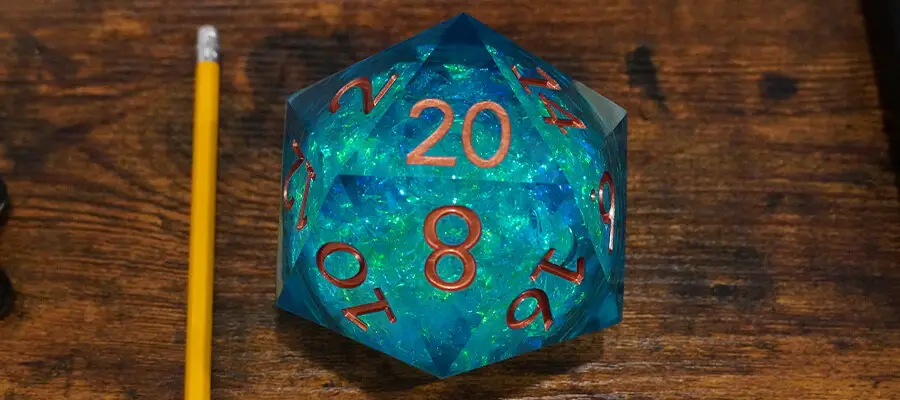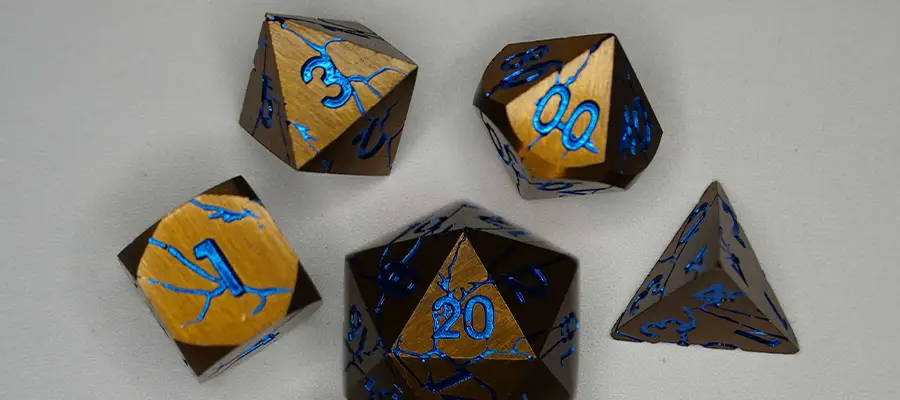Fizban’s Treasury of Dragons is a sourcebook for 5th Edition Dungeons & Dragons that takes a deep dive into one of the game’s two key namesakes: the dragons of the Material Plane. From warlords to rulers, brutes to wise sages, Fizban’s presents a broad examination of the draconic beings that add the “dragons” to Dungeons & Dragons.
In the beginning, Fizban’s tells us, there were dragons—three primordial dragons: Bahamut, the Platinum Dragon; Tiamat, the Chromatic Dragon; and Sardior, the Ruby Dragon, who together created the First World from which all branching realities of the Material Plane were born. From the ancient dragons of Toril to the draconians of Dragonlance and the Dragonmarks of Eberron, each realm in which Dungeons & Dragons takes place has been profoundly shaped by the influence of dragonkind.
In presenting this history of dragons, Fizban’s offers a portfolio of draconic lore, draconic roleplay inspiration, draconic adventure hooks, draconic statblocks, and much more. But is this love-letter to D&D’s scaly overlords worth pulling out your wallet? Here’s what you need to know.
The Good
Despite their long history in the game, dragons in D&D 5th Edition have often felt peripheral compared to other, more interesting beasts and narratives. Fizban’s upends this, giving Dungeon Masters the tools they need to give these classical monsters the depth and presence they deserve.
Fizban’s brings a welcome freshness to the unique personalities, capabilities, and interests of the chromatic and metallic dragons. It then goes further, filling out the taxonomy of dragons with new species like the psionic gem dragons, the Underdark-dwelling deep dragons, and the Fey-touched moonstone dragons. If you’ve enjoyed 5e’s recent shift away from species-based alignment, you’ll also enjoy the diversity of ideals that each type of dragon might have, from green dragons dedicated to the reverence of intelligent life to gold dragons whose pride drives them to tyrannical control.
If you’re looking for a one-stop shop on roleplaying a dragon, crafting adventures around them, or designing dungeons for them to occupy, Fizban’s has got you covered. Its draconic lairs each feel meaningfully distinct, and its expanded regional effects, lair actions, and hoard tables can all come together to make a dragon’s home feel vivid and unique—and that’s without mentioning the additional draconic minions included in its bestiary, whether that’s simple humanoid followers, an “egg hunter” parasite, or the fearsome hoard mimic. On the basis of the dragons alone, Fizban’s provides enough content diversity to fuel six back-to-back campaigns with prominent and unique draconic characters—or a single dragon-crazed campaign to give Hoard of the Dragon Queen and Tyranny of Dragons more than a run for their money. With this sourcebook in hand, it’ll be difficult to run a campaign that doesn’t prominently feature dragons in some way.
This rich vein of content extends to Fizban’s treatment of draconic lore, magic, and biology. Its discussion of the draconic view of religion, a dragon’s intrinsic magic (and how it can shape a dragon’s servants, allies, or slayers), draconic organizations (and dragon-worshipping organizations) and the alluring call of dracolichdom or communications with a dragon’s multiversal “echoes” will give any DM plentiful inspiration for new narratives and characters.
The mythic actions first featured in Mythic Odysseys of Theros and subsequently highlighted in Van Richten’s Guide to Ravenloft make a welcome third return in the statblocks of the mythical “greatwyrms”: ancient dragons who, by absorbing or destroying their “echoes” in parallel worlds, have achieved a powerful form of immortality. Several creatures in Fizban’s bestiary also highlight an array of creative new abilities, including the gem greatywyrm’s mass telekinesis ability and the elder brain dragon’s (yikes!) horrific tadpole breath.
Players, too, will find interesting new options to chew on. Fizban’s revised dragonborn, whose breath weapon now scales with a PC’s character level and who gain an additional daily “power” associated with their heritage at 5th level, are a welcome change from the Player’s Handbook’s underwhelming template. The Way of the Ascendant Dragon and Drakewarden are sure to intrigue many monks and rangers, and Fizban’s three new draconic feats and seven new draconic spells provide a flavorful cherry on top.
The Bad
Fizban’s, like any Dungeons & Dragons product, does come with its share of flaws and missed opportunities. Let’s start with the former.
Unlike prior sourcebooks and modules, Fizban’s explicitly centers D&D’s “multiverse”—including the settings of Greyhawk, the Forgotten Realms, Eberron, Dragonlance, and more—as a major portion of its lore. DMs who prefer to avoid “crossing the streams” may be disappointed with the wordcount that Fizban’s devotes to draconic “echoes” across parallel Material Planes and the greatwyrms —immortal, godlike dragons—that devour them. While many DMs will likely enjoy this novel area of lore, Fizban’s over-relies on the concept without explaining its context in D&D’s broader cosmology or even why players should care. Several areas of the text feel like they would be better-suited to an updated Manual of the Planes, rather than 5e’s answer to the Draconomicon.
When it comes to the greatwyrms themselves, missed opportunities abound. Other reviews have already noted how these godlike dragons actually lose some of the abilities that an ancient dragon would otherwise enjoy. With only a few exceptions—such as the gem greatywyrm’s mass telekinesis, mentioned above—these statblocks carry few interesting or innovative mechanics. Critics of 5th Edition’s “sack-of-hit points” model for Big Bad Boss Monsters will likely prefer to make their own revisions to each greatwyrm’s capabilities.
Other parts of the book can occasionally feel off-note or hollow. In a world where “last century” may as well be “yesterday’s news,” Fizban’s’ emphasis on dragons’ mythical longevity—a mere 1,200 to 1,400 years, barely 50 percent longer than an elf’s—feels almost quaint at best, and underwhelming at worst. Some dragons’ entries in the bestiary can feel almost too one-note; there are only so many ways that a book can remind its reader that topaz dragons “love the coast, but hate water” or that “crystal dragons enjoy eating giant spiders” before it overstays its welcome. Finally, while Fizban’s goes a long way to expand dragons’ biology and behavior, it does precious little to expand upon day-to-day draconic lifestyles. Some DMs may find it hard to believe that many such intelligent, long-lived creatures are content with a life spent reorganizing the same treasure hoards again and again for centuries on end.
Conclusions
At the end of the day, Fizban’s Treasury of Dragons is a fantastic resource for any Dungeon Master looking to put the “dragons” back into Dungeons & Dragons. While it has a few minor weak points, nearly all campaigns will find something to steal from its hoard—so long as its draconic inhabitants don’t catch you first.
You might also enjoy our articles that take monsters and develop them further for your D&D games, similar to what Fizban’s did for dragons.
About the Author: DragnaCarta is a guest writer for FlutesLoot.com and a veteran DM with 12+ years of experience. He is the author of the popular “Curse of Strahd: Reloaded” campaign guide and the Dungeon Master and director for the Curse of Strahd livestream “Twice Bitten.” You can get his personal RPG mentoring plus early access to projects by joining his Patreon.
Cast Message in the comments section below to ask DragnaCarta about this topic. You can find other articles by DragnaCarta on FlutesLoot.com.




